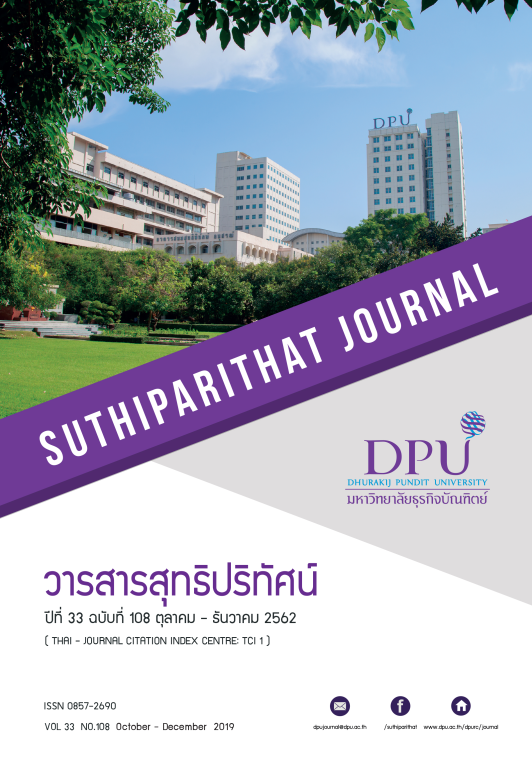BOARD OF DIRECTOR AND INNOVATION WITH PERFORMANCE OF LISTED COMPANIES IN THE STOCK EXCHANGE OF THAILAND
Keywords:
Board of Director, Innovations, Performance, Thailand Sustainability InvestAbstract
Innovation is considered as an important mechanism for driving the economy. Therefore, creating innovation is essential for every organization. To create the most useful innovation, board of director’s role in governance mechanism is a key factor. This research aims to examine the influence of board of directors and innovation towards performance of listed companies in the stock exchange of Thailand. This study applies Structural Equation Model (SEM) as an analysis technique and uses 154 Thai listed companies which are in Thailand Sustainability Investment (THSI) during 2015 to 2017 as study’s samples. The empirical results indicate a positive and significant relationship between board of director characteristics in terms of board size, director compensation and board meeting and firm performance through the influence of innovation. However, there is no relationship between board member duality and firm performance through the influence of innovation. Further study should consider the use of different research methodology such as qualitative research which may provide useful comparative. Addition information for that research results increase investor confidence that can be used to make future decisions.
References
Azar, G., & Ciabuschi, F. (2017). Organizational innovation, technological innovation, and export performance: The effects of innovation radicalness and extensiveness. International Business Review, 26(2), 324-336.
Balsmeier, B., Fleming, L., & Manso, G. (2017). Independent boards and innovation. Journal of Financial Economics, 123(3), 536-557.
Calantone, R. J., Cavusgil, S. T., & Zhao, Y. (2002). Learning orientation, firm innovation capability, and firm performance. Industrial Marketing Management, 31(6), 515-524.
Chen, C. J., Lin, B. W., Lin, Y. H., & Hsiao, Y. C. (2016). Ownership structure, independent board members and innovation performance: A contingency perspective. Journal of Business Research, 69(9), 3371-3379.
Chouaibi, J., Affes, H., & Boujelbene, Y. (2010). Characteristics of the board of directors and involvement in innovation activities: a cognitive perspective. International Journal of Managerial and Financial Accounting, 2(3), 240-255.
Dooley, L., & Sullivan, D. O. (2003). Developing a software infrastructure to support systematic innovation through effective management. Technovation, 2, 689-704.
Evans, J., & Weir, C. (1995). Decision processes, monitoring, incentives and large firm performance in the UK. Management Decision, 33(6), 32-38.
Firth, M., Tam, M., & Tang, M. (1999). The determinants of top management pay. Omega, 27(6), 617-635.
Haniffa, R., & Hudaib, M. (2006). Corporate governance structure and performance of Malaysian listed companies. Journal of Business Finance & Accounting, 33(7-8), 1034-1062.
Ho, L. H., & Chang, P. Y. (2015). Innovation capabilities, service capabilities and corporate performance in logistics services. International Journal of Organizational Innovation, 7(3), 24-33
Jackling, B., & Johl, S. (2009). Board structure and firm performance: Evidence from India’s top companies. Corporate Governance: An International Review, 17(4), 492-509.
Jensen M. C. ,& Meckling W. H. (1976). Theory of the firm: Managerial behavior, agency costs and ownership structure. Journal of Financial Economics, 3(4), 305-360.
Karabulut, A. T. (2015). Effects of innovation types on performance of manufacturing firms in Turkey. Procedia-Social and Behavioral Sciences, 195, 1355-1364.
Kato, T., & Long, C. (2005). Executive compensation, firm performance, and corporate governance in China: Evidence from firms listed in the Shanghai and Shenzhen stock exchanges. USA: Department of Economics Colgate University.
Keskin, H. (2006). Market orientation, learning orientation, and innovation capabilities in SMEs: An extended model. European Journal of Innovation Management, 9(4), 396-417.
Mehran, H. (1995). Executive compensation structure, ownership, and firm performance. Journal of Financial Economics, 38(2), 163-184.
Rubera, G., & Kirca, A. H. (2012). Firm innovativeness and its performance outcomes: A meta-analytic review and theoretical integration. Journal of Marketing, 76(3), 130-147.
Sher, P. J., & Yang, P. Y. (2005). The effects of innovative capabilities and R&D clustering on firm performance: the evidence of Taiwan’s semiconductor industry. Technovation, 25(1), 33-43.
Slater, S. F. (1996). The challenge of sustaining competitive advantage. Industrial Marketing Management, 25(1), 79-86.
Shukeri, S. N., Shin, O. W., & Shaari, M. S. (2012). Does board of director’s characteristics affect firm performance? Evidence from Malaysian public listed companies. International Business Research, 5(9), 120.
Song, S., Van Hoof, H. B., & Park, S. (2017). The impact of board composition on firm performance in the restaurant industry: A stewardship theory perspective. International Journal of Contemporary Hospitality Management, 29(8), 2121-2138.
Tidd, J. (2001). Innovation management in context: environment, organization and performance. International Journal of Management Reviews, 3(3), 169-183.
Wong, S. Y., & Chin, K. S., (2007). Organizational innovation management an organization-wide perspective. Industrial Management & Data Systems, 107(9), 1.
Wright, S. (1923). The theory of path coefficients a reply to Niles’s criticism. Genetics, 8(3), 239.
Downloads
Published
How to Cite
Issue
Section
License
Content and information of the article published at Suthiparithat Journal are based on the sole opinions and responsibility of author(s) only. Neither the editorial board involve in......







